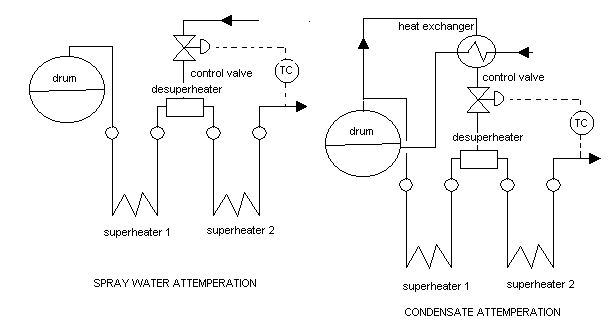

One of the methods used to control the final steamperature in a packaged boiler is interstage attemperation.In this method,feed water of demineralized quality(having nearly the same TDS as the final steam)is injected in between two stages of a superheater system as shown above.Generally in a convective type of superheater design,the uncontrolled final steam temperature decreases as the load decreases,while with a radiant superheater system,the uncontrolled steam temperature decreases as the load increases. Injecting the feed water achieves the desired final steam temperature at a given load. The load range over which the steam temperature can be maintained depends on the boiler design.Generally it is from 50 to 100 % but with special designs,the range can be extended.
When the feed water is not demineralized or has a high TDS(total dissolved solids),the amount of solids that can get into the final steam is high. For example,if the feed water has a TDS of 15 ppm and the spray quantity required is 10 % of the total steam,then a mass balance of solids around the desuperheater results in:
Solids after attemperation=(90x0 +10x15)/100=1.5 ppm,which is too much.[In this equation,steam is considered to have nearly zero solids]. Typically depending on steam pressure and turbine make,solids permitted in final steam could range from 30 to 150 ppb(parts per billion). Hence in such cases, a heat exchanger could be used to cool the steam and then inject the condensate between the two stages. This exchanger could be located inside the drum and be cooled by the boiler water itself. However another option is to use a separate exchanger as shown above and use it to cool some steam taken from the drum and then inject it as spray. The condensed steam has nearly zero solids and hence is considered suitable for spray.
![]()